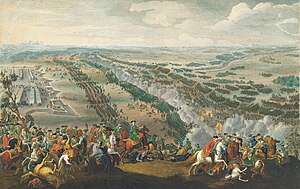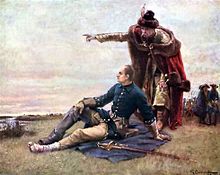This is an old revision of this page, as edited by Nikitn (talk | contribs) at 14:31, 18 December 2008 (Are you seriously joking? WTF? Just because of it's name??? Seriously, I am reporting this. And why don't we put the Swedish sources as notes? :)). The present address (URL) is a permanent link to this revision, which may differ significantly from the current revision.
Revision as of 14:31, 18 December 2008 by Nikitn (talk | contribs) (Are you seriously joking? WTF? Just because of it's name??? Seriously, I am reporting this. And why don't we put the Swedish sources as notes? :))(diff) ← Previous revision | Latest revision (diff) | Newer revision → (diff)| Battle of Poltava | |||||||
|---|---|---|---|---|---|---|---|
| Part of Great Northern War | |||||||
 The Battle of Poltava by Denis Martens the Younger, painted 1726 | |||||||
| |||||||
| Belligerents | |||||||
|
|
| ||||||
| Commanders and leaders | |||||||
| Carl Gustaf Rehnskiöld (POW) | Peter the Great | ||||||
| Strength | |||||||
|
17,000 men engaged in the battle, plus 1,300 men besieging the town of Poltava, 2,000 men left at the baggage-train and about 1,800 men at lower Vorskla River and an unknown number of not involved Cossacks According to Ukrainian sources: 31,000 | Total strength of 46,000 men, 110 cannons used in battle plus an unknown number of irregular Kalmyks and Cossacks | ||||||
| Casualties and losses | |||||||
|
6,900 killed and wounded, 2,800 captured. According to Ukrainian sources: 9300 dead |
1,345 killed 3,290 wounded. | ||||||
| Great Northern War | |
|---|---|
|
The Battle of Poltava (Template:Lang-ru, Template:Lang-sv) on 27 June 1709 (8 July, N.S.) was the decisive victory of Peter I of Russia over Charles XII of Sweden in the most famous of the battles of the Great Northern War. It is said to have started the end of Sweden's role as a Great Power and the Russians took their place as the leading nation of northern Europe. This also meant the rise of Imperial Russia.
Prelude
Early Swedish victories at Copenhagen and at the Battle of Narva in 1700 knocked both Denmark and Russia temporarily out of the war. However, Charles XII was unable to bring the war to a conclusion, and it would take six years before he had dealt with the remaining combatant Augustus II of Saxony-Poland. During this time Peter I rebuilt his army into modern form, basing it primarily on infantry trained to properly use linear tactics and modern firearms. He then achieved a stunning propaganda victory when he established the city of Saint Petersburg on Swedish territory, not Livonia. To end the war, Charles ordered a final attack on the Russian heartland with a possible assault on Moscow from his campaign base in Poland. The Swedish army of almost 44,000 men left Saxony on August 22, 1707 and marched slowly eastwards. When they reached the Vistula River they waited for it to freeze and didn't cross until December 30, then continued through a hostile Masuria and took Grodno on January 28, 1708 after the Russians had left without any fight. The Swedes continued to the area around Smorgon and Minsk where the army went into winter quarters. Left in western Poland were 8,000 dragoons under major-general von Krassow.
The Swedish army, that had suffered badly from different epidemic diseases during the winter, left its quarters in early June 1708 and marched towards Smolensk. During the spring General Lewenhaupt in Courland had been ordered to gather supplies and march with his army of about 12,000 men to join Charles army. Although he didn't leave Mitau until late June and couldn't join Charles forces until October 11.
At one point they were only 130 kilometres apart, but Charles gave up because he needed supplies, and turned south into Ukraine in search of grain and better weather. The Ukrainian forces, under the command of the Cossack hetman Ivan Mazepa, had been in discussions with Charles for some time, and at this point officially allied himself to the Swedes in order to gain independence from Russia.
Lewenhaupt followed south and was attacked while crossing a river near a small village that gave name to the Battle of Lesnaya. His forces met the Russian attack, but they were amazed to find that the new Russian army gave them a serious fight. Lewenhaupt, seeing that he was about to lose, decided to rejoin Charles with all speed, so he abandoned the cannon, the cattle and most of the food, driving the soldiers to mutiny. Stealing all of the alcohol, the soldiers became drunk, and Lewenhaupt was forced to leave about 1,000 men drunk in the woods. By the time they finally reached Charles and the main force in the winter, no supplies and only 6,000 men remained.

In the spring Charles resumed his advance, but his army had been reduced by about one-third due to starvation, frostbite and other effects of the weather. The wet weather had also seriously depleted the army's supplies of gunpowder; the cannon were also essentially out of action, due to a lack of usable ammunition. Charles's first action was to lay siege to the fort of Poltava on the Vorskla River in the Ukraine. Peter had already organized a huge force to protect it, and he quickly arrived. On 27 June, Charles received information that large Kalmyk forces were going to join Peter and to cut off all supplies of Swedish Army.
Battle
When the battle opened, Charles had about 14,000 men, while Peter commanded about 45,000. To make matters worse for the Swedes, Charles was wounded during the siege on June 17, when he was hit in the foot while taking part in a small engagement during an inspection of the Swedish outposts on the banks of the Vorskla. He had to turn over command to Field Marshal Carl Gustav Rehnskiöld and General Adam Ludwig Lewenhaupt. This was made all the more unfortunate by the divergent personalities of the two generals. The change in command was not communicated to the subordinate commanders when the battle was planned. Also the Russians managed to weaken the Cossacks who decided to join Swedes against them. The Russian army deceitfully occupied and destroyed the Zaporozhian Host with the help of Galagan, a former Cossack officer. The rest of the Cossacks moved their Host down the Dnipro river for the next 19 years.
The battle began before dawn at 3:45 a.m. on June 28, with the Swedes advancing boldly against the Russian fortified lines. At first, the battle started off in a traditional fashion, with the better trained Swedes pressing in on the Russians' redoubts, overrunning a few Russian defensive redoubts. The Swedish seemed to possess an advantage, but this was quickly nullified. By dawn, the weather was already very hot and humid with the rising sun obscured by smoke from cannon and musket fire. The Swedish infantry, commanded by General Lewenhaupt, attempted to attack the Russians. But the Swedish advance soon faltered, partly because the infantry had been ordered to withdraw and reorganise. To make matters worse, one Swedish detachment, commanded by General Roos, hadn't been told about the overall plan and became isolated in the Russian defensive redoubts when a column of about 4,000 Russian reinforcements reoccupied the fortified positions, trapping Roos and his 2,600-man force. With over 1,000 casualties and ammunition running low, Roos was forced to surrender his command.
The Swedes waited for Roos to return. As time went by, the Russians infantry moved out of its fortified camp. Around 9:00 am, the Swedish line started to move forward; 4,000 Swedish infantry against 20,000 Russian infantry. They advanced and the Russians opened fire on them with their guns creating a firestorm of shells. When the Swedes were 100 meters from the Russian line, the Russians aimed and fired their muskets. When they were 30 meters from the Russian line, the Swedes fired one volley and charged. They were on the verge of a breakthrough and needed the cavalry; unfortunately for the Swedes, it was disorganised. The Russian line was longer than the Swedish line, and the Russian right soon flanked the Swedish infantry. Several regiments were surrounded in a classic Cannae-style battle. The cavalry tried to buy the infantry time to get away; several units attacked the Russians head on despite them forming into squares. Seeing the defeat of his army from a stretcher in the rear, Charles ordered the army to retreat at 11:00 a.m. By noon, the battle was over as Russian cavalry had mopped up the stragglers on the battlefield and returned to their own lines. Charles then gathered the remainder of his troops and baggage train, and retreated to the south later that same day, abandoning the siege of Poltava. Rehnskiöld was captured. Lewenhaupt led the surviving Swedish and some of the Cossacks forces to the Dnieper River, but was doggedly pursued by the Russian regular cavalry and 3,000 Kalmyks and forced to surrender three days later at Perevolochna, on July 1. Many of Mazepa's Cossacks changed sides joining the Russian army right after the battle.
Aftermath


Several thousand prisoners were taken, many of whom were put to work building the new city of Saint Petersburg. Charles managed to escape with about 1,500 men to Bendery, Moldavia, then controlled by the Ottoman Empire, and spent five years in exile there before he was able to return to Sweden. Poltava can be considered as one of the most disastrous defeats ever, when looking at casualties in percentage of the armies size, and is seen as the most disastrous defeat in Swedish history.
Popular culture
The battle was portrayed in the monumental 1925 Swedish film Karl XII with Gösta Ekman as king Charles XII and the Russian emigrant actor Nicolai de Seversky as Peter I. Recently the battle was also portrayed in the 2007 Russian film The Sovereign's Servant (Template:Lang-ru, Sluga Gosudarev).
Notes
- ^ There were factions of the Dnieper Cossacks allied with each of the combatants.
- Lars Ericson: Svenska Slagfält, p.294. Wahlström & Widstrand 2003. ISBN 91-46-21087-3.
- Peter Englund: Poltava, p.84, 215. Atlantis 1988. ISBN 91-7486-834-9.
- The number of cossacks left around Ivan Mazepa, who where standing at Pushkarivka, were at the time of the battle at the most 3,000. Christer Kuvaja: Karolinska krigare 1660–1721, p.191. Schildts Förlags AB 2008. ISBN 978-951-50-1823-6.
- Encyclopedia of Ukraine
- Валерий Алексеевич Молтусов: Полтавская битва. Новые факты и интерпретация. Moscow 2002.
- Peter Englund: Poltava, p.215. Atlantis 1988. ISBN 91-7486-834-9.
- Christer Kuvaja: Karolinska krigare 1660–1721, p.192. Schildts Förlags AB 2008. ISBN 978-951-50-1823-6.
- Encyclopedia of Ukraine
- Encyclopedia of Ukraine
- Christer Kuvaja: Karolinska krigare 1660–1721, p.192. Schildts Förlags AB 2008. ISBN 978-951-50-1823-6.
- 28 June according to the then-used Swedish calendar
27 June in the old style
8 July in the new style - Christer Kuvaja: Karolinska krigare 1660–1721, p.179. Schildts Förlags AB 2008. ISBN 978-951-50-1823-6.
- Christer Kuvaja: Karolinska krigare 1660–1721, p.180–185. Schildts Förlags AB 2008. ISBN 978-951-50-1823-6.
- The Internet Movie Database
- The Internet Movie Database
Bibliography
- G. Adlerfelt, The Military History of Charles XII, King of Sweden, Written by the Express Order of His Majesty. London, 3 vols, 1740.
- Mykhailo Hrushevskyi, Illustrated history of Ukraine. Donetsk, 2003. ISBN 9665485717
- Peter Englund, The Battle That Shook Europe: Poltava and the Birth of the Russian Empire. London, 1992, 288 pages. ISBN 1860648479
- Angus Konstam, Poltava 1709, Russia Comes of Age. Osprey Campaign #34. Osprey Publishing, 1994, 96 pages. ISBN 1855324164
- Robert K. Massie, Peter The Great: His Life and Times Ballantine Books; 1981. 932 Pages, ISBN-10: 0345298063 : ISBN-13: 978-0345298065
See also
External links
49°34.47′N 34°34.12′E / 49.57450°N 34.56867°E / 49.57450; 34.56867
Categories: